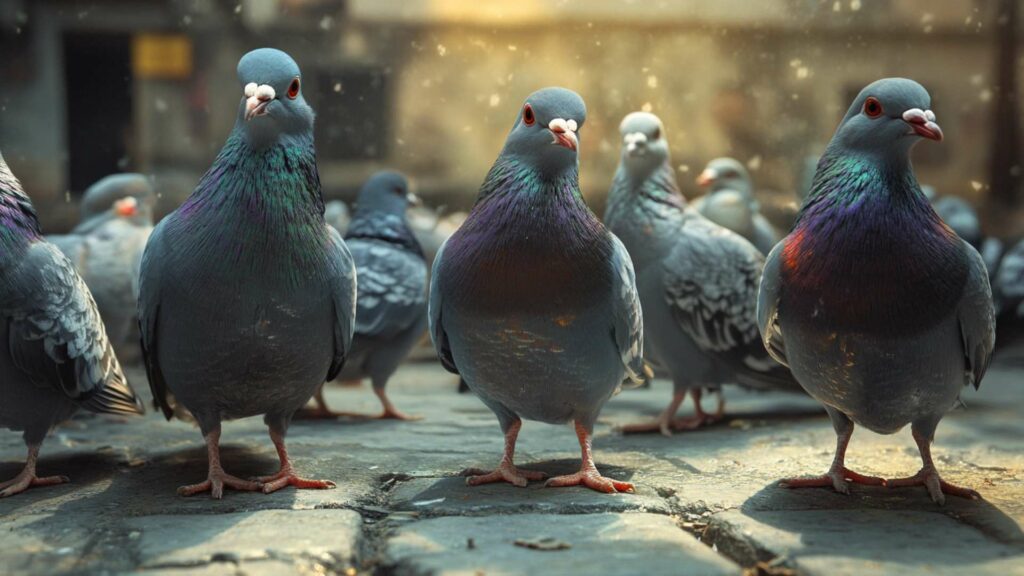Curiosity strikes: Can rats really eat pigeons? It’s a question that captivates the imagination, conjuring images of unlikely predator-prey interactions in our urban landscapes.
Rats and pigeons are both common sights in cities, but do their paths ever cross in a deadly manner? Let’s delve into the depths of this intriguing question and unveil the truth behind it.
Curiosity strikes: Can rats really eat pigeons?
When we think of rats, we often associate them with scavenging behaviors, feeding on garbage, or raiding our pantries. Pigeons, on the other hand, grace our skies and cityscapes with their majestic presence. So it’s natural to wonder if these two creatures’ worlds collide in a more sinister way.
Can rats truly be capable of hunting down and devouring pigeons? Rats are omnivorous creatures by nature, meaning they have a diverse palate and can feed on both plant-based matter and live prey.
While their primary diet typically consists of smaller animals like mice or insects such as crabs — which they hunt, fight for territory, or consume as available resources — larger birds like pigeons are not usually considered typical prey for rats. However, nature has its surprises, and sometimes unexpected predator-prey dynamics unfold right under our noses.
Rat Diet Basics

Rats, known for their adaptability and resilience, are opportunistic feeders with an omnivorous diet. This means that they can consume a wide variety of foods to meet their nutritional needs.
While grains, fruits, and vegetables make up a significant portion of their diet, rats are not limited to plant-based foods alone. They possess the remarkable ability to adapt and consume proteins from both animals and plants.
Varied diet preferences and adaptability
Rats exhibit an impressive level of dietary flexibility, allowing them to thrive in various environments. Their food preferences depend on availability, which makes them opportunistic eaters capable of adapting to different food sources in urban settings.
Rats have been observed consuming and eating everything from discarded human food waste and seeds to insects and small vertebrates like mice or birds. In terms of adaptability, rats’ ability to survive on diverse diets contributes significantly to their success as a species.
Their exceptional gastrointestinal system enables them to digest a wide range of foods effectively. This adaptability grants them an advantage over other animals when it comes to finding sustenance in both natural habitats and urban environments.
Nutritional requirements for survival
To maintain optimal health and survival, rats require specific nutrients from their diet. Proteins are crucial for growth, repair of tissues, and overall body function.
Rats obtain proteins from sources such as insects or small birds if available but can also derive it from plant-based protein-rich foods like legumes or grains. Carbohydrates provide energy for daily activities; these are found in abundance in grains like rice or wheat that rats may consume when available.
Fruits and vegetables contribute essential vitamins and minerals necessary for metabolic processes. It’s important to note that while rats have been observed consuming small birds during certain circumstances where other food sources are scarce, it is not a common occurrence.
Rats generally do not actively seek out and attack birds or live prey like pigeons. Their opportunistic nature allows them to adapt their diet based on availability and convenience rather than a specific inclination to eat pigeons or other birds.
Pigeons: A Potential Rat Meal?

Ah, pigeons, those ubiquitous feathered creatures that grace the urban landscapes with their presence. Found in bustling cities worldwide, these birds have adapted remarkably well to human environments.
With their distinctive cooing and feathery plumes, pigeons have become a familiar sight on rooftops, park benches, and city squares. Their ability to thrive in crowded spaces makes them an ideal target for curious minds wondering if they could be on a rat’s menu that night.
Rats’ opportunistic feeding behavior
Now let’s talk rats – those sneaky nocturnal creatures with a reputation for being resourceful scavengers. Rats are known for their opportunistic feeding habits; they can eat almost anything that comes their way.
From fruits and vegetables to other small mammals, birds, and even fish, these cunning critters have developed a diverse palate over the years. Their adaptability allows them to survive in various environments by making do with whatever sustenance is available.
Assessing the possibility of rat-pigeon interactions
With such an array of culinary choices at their disposal, it’s natural to wonder if pigeons are potential targets for rats’ voracious appetites. While it is true that rats will opportunistically feed on small birds and eggs when given the chance, predation on pigeons seems less likely due to several factors.
Pigeons are not only larger than typical prey items for rats but also possess certain adaptations that make them less vulnerable. Pigeons are skilled fliers capable of swift takeoffs and impressive aerial maneuverability; this flight ability acts as an advantage against ground-dwelling predators like rats who lack similar mobility in the air.
Additionally, pigeons tend to roost in elevated locations such as rooftops or ledges, making it harder for rats to catch them off guard. However, while the possibility of rat-pigeon interactions exists, documented cases are relatively rare and often influenced by unique circumstances.
So, while pigeons may occasionally find themselves in close proximity to rats in urban settings, the likelihood of them becoming a regular part of a rat’s diet is relatively low. These resourceful scavengers have an array of other options available to fulfill their dietary needs without having to set their sights on our feathered friends.
Rats vs. Pigeons: The Size Factor
When it comes to comparing rats and pigeons, it becomes evident that these creatures differ significantly in terms of physical characteristics. Rats, with their sleek bodies and long tails, possess a nimble agility that enables them to navigate through nooks and crannies effortlessly. On the other hand, pigeons flaunt their plump bodies adorned with feathers of various hues.
Their wings allow them to take flight, reaching the skies with graceful ease. Despite rats being smaller in size compared to pigeons, they possess certain traits that can help them overpower larger prey.
One such attribute is their remarkable ability of teamwork or employing ambush tactics. Rats are known to be cunning opportunistic feeders who employ intelligent strategies while hunting.
When faced with a larger target like a pigeon, they may coordinate as a pack to distract or corner their prey effectively. Alternatively, rats might use stealth and patience when ambushing unsuspecting birds that may be slow-moving or preoccupied with their surroundings.
Subverting Expectations: The Rat’s Predatory Prowess
While it may seem counterintuitive for a small rat to tackle a sizable bird like a pigeon, these rodents have demonstrated remarkable adaptability in hunting techniques when presented with an opportunity. In certain instances where pigeons become injured or incapacitated due to accidents or illness, rats may seize the chance to exploit their vulnerability.
In urban areas where birds congregate around feeding areas or bird aviaries provide easy access for scavengers like rats, there have been occasional reports of rat-pigeon interactions resulting in predation attempts by the rodents. These events are uncommon but notable exceptions that highlight the versatility of rats as opportunistic feeders.
Rat Predation Behavior and Techniques

When it comes to studying rat predation behavior, researchers have delved into the fascinating world of these stealthy creatures. Through meticulous observation in various natural environments, their hunting and breeding strategies have been revealed. Rats, being highly adaptable and opportunistic feeders, have developed different techniques to secure their meals.
Ambush Predation: Exploiting Vulnerabilities
One of the tactics rats employ is ambush predation. They take advantage of vulnerabilities in their prey’s surroundings to strike and kill them swiftly and efficiently.
When it comes to smaller birds like pigeons, rats often lurk close by, hidden within the shadows of buildings or behind objects, patiently waiting for an opportunity. Once a bird ventures near enough or displays any signs of weakness or distraction—such as feeding on the ground or preening its feathers—rats pounce with lightning speed.
Their sharp teeth and agile movements allow them to incapacitate their targets before they can react. However, it is important to note that adult birds are typically more challenging for rats to attack due to their size and ability to immediately fly away from potential danger.
Pack Hunting: Strength in Numbers

Rats are also known for employing pack hunting techniques when circumstances call for it. Working together as a coordinated unit, they exhibit remarkable teamwork while attempting more substantial prey such as larger bird species or animals.
By surrounding the target from different angles or distracting it with synchronized movements, rats can increase their chances of success significantly. However, it should be noted that while pack hunting does occur among rats under certain circumstances, this behavior is less commonly observed when targeting pigeons specifically.
In addition to ambush predation and pack hunting strategies, rats are opportunistic feeders, meaning they make the most of any available food source. Pigeons’ nests, containing eggs or vulnerable baby birds, can attract rats due to their high nutritional value and relative accessibility.
Rats will of course not hesitate to exploit such opportunities as part of their survival instinct. However, it is worth noting that pigeons have also evolved certain adaptations to protect their offspring and nests, making them less vulnerable to rat attacks.
Rats exhibit various predation techniques in natural environments. Ambush predation allows them to exploit vulnerabilities in smaller birds like pigeons, while pack hunting enables them to tackle larger prey if necessary.
Additionally, their opportunistic feeding habits make them resourceful scavengers capable of seizing any chance for a meal. However, specific circumstances and the defensive adaptations of adult birds can limit the instances where rats successfully prey upon pigeons.
Urban Environments and Rat-Pigeon Interactions
In bustling urban environments, rats and pigeons are no strangers to each other. Both species have adapted remarkably well to the concrete jungles we call cities. One reason for their coexistence is the overlapping of their habitats.
Pigeons seek refuge on rooftops, ledges, and parks where they find ample food sources like discarded crumbs or bird feeders. Similarly, rats thrive in these same environments due to the abundant garbage that provides them with an all-you-can-eat buffet.
As a result, competition for resources between rats and pigeons can be fierce. This overlapping habitat creates a natural rivalry as both species attempt to secure their own survival.
Rats, being omnivorous creatures, are always on the lookout for any available food source, including other birds like pigeons. However, while resource competition may occasionally lead to conflicts between rats and pigeons in urban areas, it’s important to note that rat-pigeon interactions involving direct predation are relatively rare occurrences.
Instances of rat-pigeon interactions observed in cities
Although instances of rats attacking pigeons are not common in urban areas, there have been some documented cases of such encounters. These incidents typically involve specific circumstances where the pigeon becomes vulnerable or compromised in some way.
For instance, if a pigeon is injured or sickly, its weakened state may make it an easier target for a rat looking for an opportunistic meal. Additionally, slow-moving birds or those caught off-guard could potentially fall victim to a rat’s ambush tactics.
While these encounters may be atypical and infrequent in urban settings with healthy pigeon populations, researchers have reported isolated incidents where rats have indeed preyed upon pigeons. It’s important to remember that despite occasional interactions between rats and pigeons in cities, these instances are not representative of the norm.
Pigeons generally have an advantage over rats due to their flying abilities, making it harder for ground-dwelling predators like rats to successfully attack them. The dynamic between these two species is primarily shaped by resource competition rather than direct predation.
Unusual Predation Cases
In the realm of animal predation, there have been a few rare instances where rats have been observed preying on pigeons. These cases, though unusual, have been documented by researchers and humans who were fortunate enough to witness such events.
One such study conducted in urban areas found that rats occasionally targeted pigeons as part of their diet. The researchers observed that the rats utilized their agility and speed to surprise and overpower unsuspecting pigeons, often targeting smaller or weaker individuals within flocks.
These documented cases shed light on the versatility of rat feeding habits and their ability to adapt to various food sources. While rats are primarily omnivorous and usually prefer a diversified diet consisting of grains, fruits, vegetables, and smaller prey such as mice or insects, their opportunistic nature allows them to exploit any available resource for survival – including birds like pigeons.
Several factors contribute to these exceptional cases where rats prey on pigeons. One key factor is the presence of abundant food sources in close proximity to each other and killing the other. Urban environments with a high concentration of human settlements often provide an array of food options for both rats and pigeons.
For instance, chicken coops where grains are stored may attract both species. Additionally, situations where baby pigeons become separated from adult birds due to nest disturbances or accidental falls create vulnerable opportunities for rats to catch them off-guard.
Younger birds may not possess fully developed flight capabilities, making them more accessible targets for opportunistic rats. While these rare instances highlight the adaptability and opportunism within rat behavior when it comes to finding nourishment, it is important to note that they remain infrequent occurrences in comparison to their typical dietary preferences.
Limitations for Rats Hunting Pigeons

When it comes to evading predators, pigeons possess a remarkable advantage over rats with their exceptional flight abilities. These birds are adapted for swift and agile movement through the air, enabling them to quickly escape potential threats on the ground. With their strong wings and aerodynamic bodies, pigeons can take off rapidly and fly at impressive speeds, making it difficult for rats or other ground-dwelling predators to catch them in open spaces or while perched on higher building structures.
Moreover, pigeons have the ability to maneuver effortlessly through cluttered urban environments. Their keen spatial awareness enables them to navigate narrow alleyways, dodge obstacles such as lampposts or tree branches, and swiftly change direction in response to potential threats.
This agility gives pigeons a distinct advantage in eluding rats, pests that rely on close proximity and confined spaces for successful hunts. In essence, the pigeon’s ability to take to the skies is a crucial factor that limits rat predation on these birds.
Pigeons possess certain adaptations that contribute further to their defense against rat attacks. First and foremost is their keen sense of awareness.
Pigeons are naturally alert creatures with excellent vision and hearing capabilities that enable them to detect potential danger from afar. They can spot approaching predators like rats eating birds prowling nearby or any sudden movements in their surroundings.
Additionally, pigeons have evolved a set of defensive behaviors when faced with danger. For instance, when threatened by a predator like a rat, they may engage in vigorous flapping of wings accompanied by loud cooing sounds as warning signals intended to startle or intimidate the aggressor.
This behavior not only serves as an alert system for other pigeons but also highlights the pigeon’s willingness to stand its ground and fight back if necessary. Furthermore, pigeons often gather in large flocks, creating a collective defense mechanism against potential threats.
By sticking together, they increase their chances of spotting an approaching rat and can quickly take flight as a coordinated unit. This safety-in-numbers strategy makes it harder for rats to single out an individual pigeon for an attack.
The combination of pigeons’ flight abilities and their adaptations for self-defense significantly limits rat predation on these birds. While rats may occasionally prey on weaker or injured pigeons, the overall ability of pigeons to escape through flight and utilize defensive behaviors mitigates the risk posed by rat attacks.
Conclusion
After delving into the intriguing question of whether rats can eat pigeons, we have learned that while it is uncommon, it is indeed possible for rats to prey on these urban birds. Rats, being opportunistic omnivores with the ability to adapt their diet to various food sources, can resort to attacking and consuming pigeons under certain circumstances.
However, it is important to note that such instances are not widespread or typical in rat behavior. Rats possess a diverse diet that includes grains, fruits, vegetables, insects, and occasionally small animals like mice or birds.
While they are capable of hunting live prey when necessary for survival, targeting adult birds like pigeons proves challenging due to several factors. Pigeons have evolved flight abilities as a defense mechanism against ground-dwelling predators like how rats kill birds.
Additionally, their adaptations such as keen awareness and flocking behavior make them less vulnerable to rat attacks. While there may be isolated incidents where rats have been observed preying on pigeons in urban environments with overlapping habitats and limited resources, the overall likelihood remains low.
The natural instincts and physical characteristics of both species typically prevent frequent encounters leading to rat predation on pigeons. It’s important not to fear these creatures or jump to conclusions based on exceptional cases; instead, let us appreciate the remarkable adaptations that enable both rats and pigeons to navigate their shared surroundings peacefully.
Prevent Pigeon Troubles with D-Termination: The Top Choice for Pest Control in Las Vegas!

If you’re dealing with pigeon-related challenges, D-Termination is your go-to solution. Our team of specialists excels in pigeon deterrence and revitalizing cleanliness and integrity in your environment. Bid farewell to pigeons by opting for D-Termination’s highly efficient pest control today!
Reach out to us at 702-919-6310 or visit dtermination.com to arrange your pigeon control service and regain your space from these unwelcome pests.
Frequently Asked Questions:
Rats may eat dead pigeons if they come across them.
Pigeons can sometimes deter rats, but it depends on the specific circumstances.
Pigeons and rats generally do not get along and may compete for food and shelter.
Yes, rats can eat birds, particularly if they are small or vulnerable.







